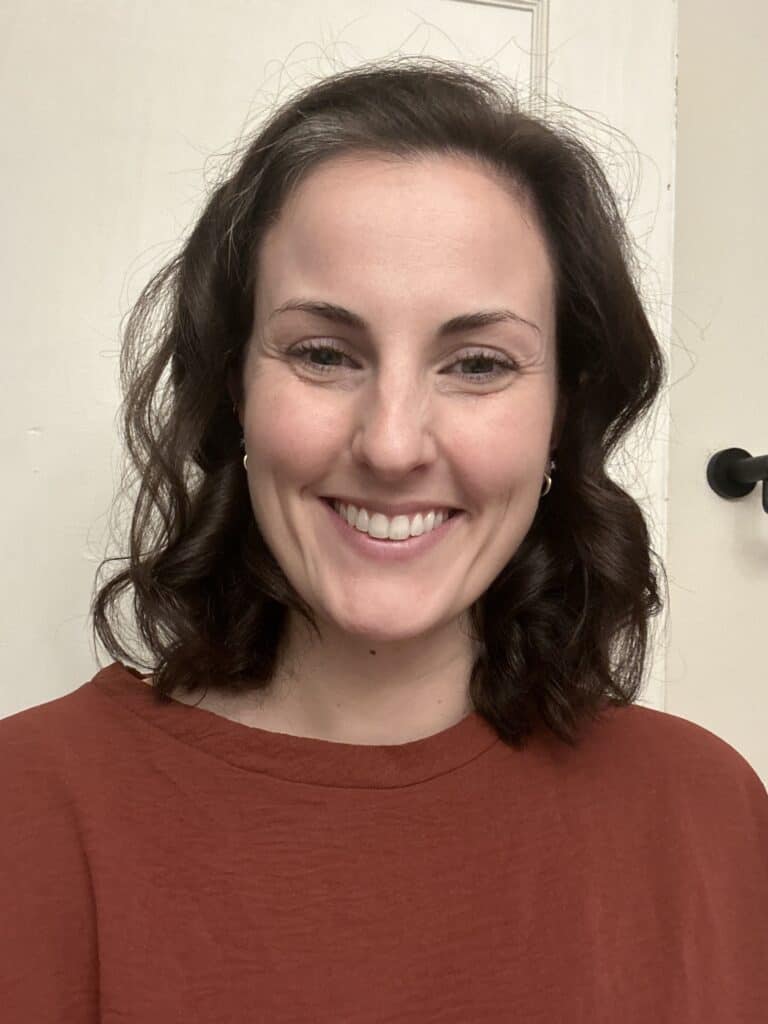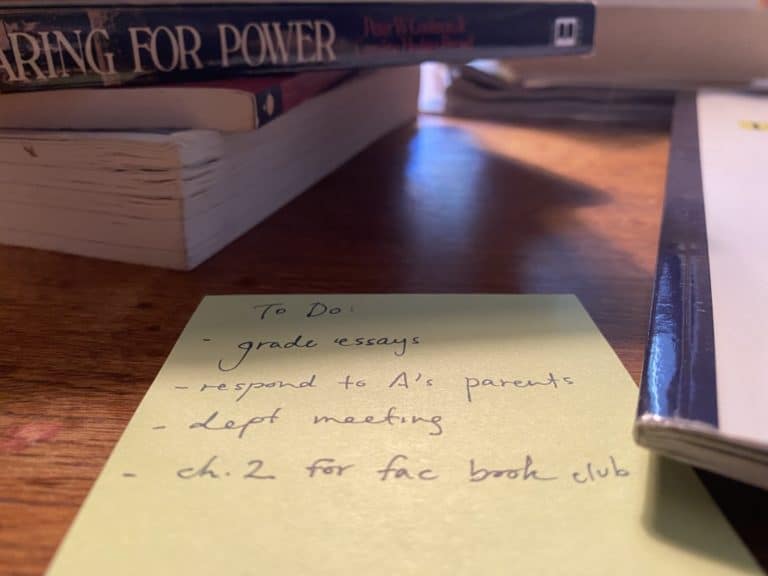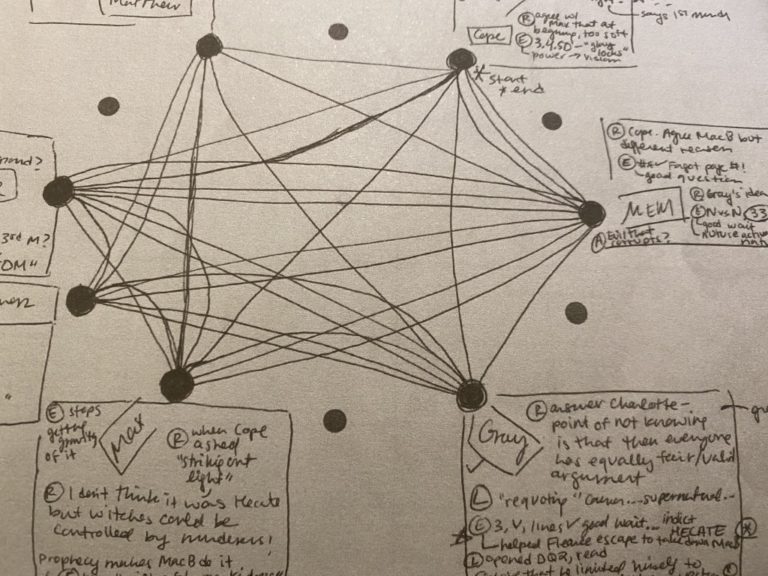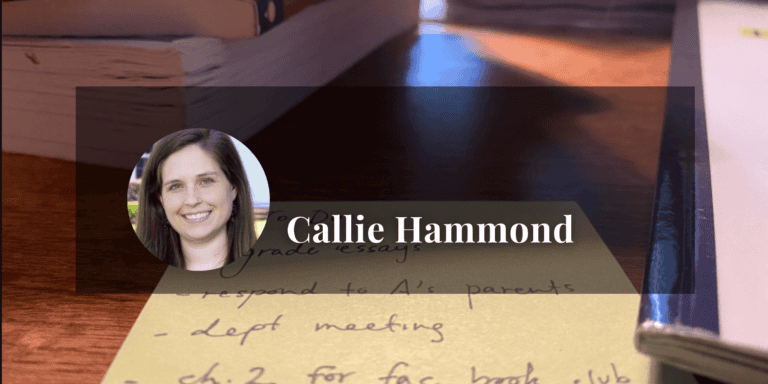Teacher Feature: Kacie Neville
Thank you to Kacie Neville for sharing her R.E.A.L. life with us! Kacie is an English teacher at Cleveland Central High School, a public high school in Cleveland, MS. Here are her thoughts on discussion, R.E.A.L.®, and learning. This interview has been lightly edited for clarity.

Name: Kacie Neville
Hometown: Chapel Hill, North Carolina, but I currently live in Cleveland, Mississippi.
Current school: I teach tenth grade English at Cleveland Central High School but will be taking on a new position as principal of an elementary school next year.
Thank you so much for speaking with us today, Kacie! We always like to start by asking you to think back to when you were a student. How would you describe yourself as a student in three words?
Talkative would definitely be one. I was an avid reader. And I don’t know what the third one would be, but I liked getting good grades; I was very grade-motivated as a child.
Tell us about your journey as a teacher and administrator. What got you interested in teaching, and how did you land at your current school?
It’s been quite a journey! I joined Teach For America after undergrad, and I had studied business, so teaching wasn’t even really on my radar. I got interested in Teach For America through extracurricular activities that I was involved in in college. When I joined Teach for America, they placed me in Mississippi for my first two years. I taught at a school that’s about 10 miles south of where I live right now. I stayed past my commitment to do a third year and then moved out to Los Angeles, California to teach at a charter school. Then I moved back to Mississippi to work as a teacher coach with Teach for America for five years. I coached novice teachers while I was in grad school at Penn and also while I was in grad school at a local university here called Delta State University. In 2022 I decided I wanted to go back into the classroom, because I wanted the experience of teaching after COVID. I was coaching while people were teaching during COVID, and it caused a really big shift, especially where I live and work, in terms of access to technology. When I first started teaching, my school didn’t have computers, it was very low tech, and now it’s one-to-one everywhere, and that’s a totally different thing to manage. I was watching a lot of things change, especially around the teaching of reading in Mississippi, and wanted to see how that’s playing out in the classroom before becoming an administrator. I’m about to embark on my first administrative position at a magnet Elementary School in the same district that I currently teach in.
Thinking about your path and how you were able to take a bird’s eye view as an instructional coach and work with a bunch of different teachers at different schools: What do you think has changed the most in terms of student needs or student challenges over that time?
I think this was true before, but we have words for it now – we’re seeing the incredible impact that a strong social environment can have for students. COVID really laid that bare. There were a lot of teachers who were talking about it as an individual thing. For instance, I’d hear them talk about how “I create this kind of environment for my classroom. This is how my students feel about each other.” But really it felt like it was left to the individual teacher.
Once students came back from spending a year or two out of a social environment, and we saw the ramifications of that, folks really started to see how we needed more intentionality around that in our schools. We couldn’t just be like, “Okay, we’ll drop them back together and they’ll figure it out.”
Kacie Neville
Once students came back from spending a year or two out of a social environment, and we saw the ramifications of that, folks really started to see how we needed more intentionality around that in our schools. We couldn’t just be like, “Okay, we’ll drop them back together and they’ll figure it out.” I’ve been teaching students who were in middle school when they were virtually learning. We weren’t setting them up to speak to each other academically or learn how you listen to another person when they’re speaking. And I think that the increased access to technology also creates some of that communication barrier. So we’re working on multiple fronts and dealing with the fact that a lot of their communication and relationship-building skills are happening on external platforms.
Keeping those changes in mind, when you think about class discussion, what is your “why”? What feels compelling and important to you about teaching these particular skills?
So many things! I work with a population of students who, on average, are operating several years behind their reading grade level. But there’s a big push, as there should be, for them to be accessing grade level material. In class I get richer and more thoughtful responses from them orally than I do in writing. It’s too many processing layers for our brains which are programmed to communicate orally – it’s genetically how humans operate and how we operate socially. Writing and reading are actually not natural processes for our brain. We learn them. But when you’re struggling with reading and you’re struggling with writing, it is so hard to express yourself that way. So for me, students having the ability to take their ideas the way they would say them, work on them, and then share them with others to level up the depth of those ideas is a very appealing prospect. I’ve known for years that I get better responses and more engagement with the text if we’re doing it with our voices than just with pencil and paper. Even with students who are struggling to read, sometimes I am just blown away by some of the stuff that they’ll say and how much they understand when all I’ve been doing is reading their worksheets, which are not giving me an accurate representation of how much they truly comprehend.
So for me, students having the ability to take their ideas the way they would say them, work on them, and then share them with others to level up the depth of those ideas is a very appealing prospect. I’ve known for years that I get better responses and more engagement with the text if we’re doing it with our voices than just with pencil and paper.
kacie Neville
That really goes back to the point you were making before: if students are doing this thinking in isolation, they’re missing the social-emotional piece. They’re also missing that opportunity to have more discussions to build their understanding and see if everybody else gets this concept or not.
Yeah, during the pandemic teaching virtually was like teaching to a blank wall. Kids weren’t talking to each other. So imagine a student sitting there thinking that they don’t get it, but no one else is expressing that they don’t get it. You’re just going to sit in your own misunderstanding. That organic piece is missing when we’re not together. I just did a student survey, and one of the things that students said they like best about this class was the discussions we have, the things we talk about. And then their least favorite thing was reading. I thought that’s funny because when we talk about the reading, you’re really into it! So I think the discussion amps up the engagement in something that could potentially be less engaging or hard to access.
That’s a really good point! Tell me a little bit about how you’ve been structuring R.E.A.L. Discussions in your class. What does it look like with a large group?
We’ve done two full R.E.A.L. Discussions in groups, and we also do what I’m calling “Mini-R.E.A.L.s” in centers. They work in small groups of four or five and move around in six centers. They move through three centers one day, three the next day like a circuit. Each center lasts about 15 to 20 minutes. They all start in different places. One center is for DQ Prep and another is for discussion. The other centers are ones that they do all the time – like vocabulary, independent reading, grammar – so they are good at self-managing at those centers. There’s a group that starts at the discussion table, which is my table, and I usually start my struggling group there. I help facilitate that discussion and the DQ Prep for that group. Everyone else primarily does it independently, but I try to keep the discussion happening at my center, so that I can hear what they’re saying. Occasionally I’ll jump in and be like, oh this has sparked a new idea for me too!
I think that’s a brilliant structure, especially for scaffolding the routines! Are there any other things – especially when it comes to texts and DQs – that would be helpful for a teacher teaching a large class?
A lot of it is like any classroom structure or system. It’s about practicing and holding students accountable to doing it the way that it’s laid out and just making sure that the content is aligned with what it is you’re asking them to do.
kacie nevillve
A lot of it is like any classroom structure or system. It’s about practicing and holding students accountable to doing it the way that it’s laid out and just making sure that the content is aligned with what it is you’re asking them to do.
Timing it so that the discussions are at a place in the curriculum where there’s enough for them to discuss is important too.
My curriculum has theme-based units and some pretty good essential questions for each unit. I tweak some of those as the discussion questions, so that they can pull from multiple texts to support. The second discussion was very aligned to the essay they were going to have to write at the end. So they used their DQ Prep as their collection of evidence for the essays. And when they realized that’s what was happening, they were like, “We’ve already done this! I’ve seen this question before!” So they were excited to be able to use their workbooks while they were writing their essays. And those were some of the better essays I’ve gotten this year – they were the most well thought-out and had the most evidence. I think it was because we had layered on collecting evidence, discussing it, and adding to our writing.
Thinking back on this year, does a moment come to mind where you saw a student have a breakthrough during discussion? What did it look like, and did you see it have an impact on other students?
One of the moments I’m thinking of was a moment of conflict between two students in a R.E.A.L. Discussion group who were fully misunderstanding each other. They were using the same word to mean very different things. They were going back and forth, and their whole group was watching them. Eventually another student stepped in and was like, “I think that you guys disagree, but the reason you disagree is because when he says this, this is what he means, and when she says this, this is what she means. Is that right?” And then they agreed that was right. And that was really great, because they were starting to get frustrated with each other. But to have another student feel comfortable enough to step in and be like, “Hey, I’ve been watching this volleyball for a while, and I have a thought!” was really cool, and I highlighted it to the class afterwards. Sometimes discussions lead to conflict, and that’s okay. When we’re open to listening, like that student was, we can take it to the next level.
to have another student feel comfortable enough to step in and be like, “Hey, I’ve been watching this volleyball for a while, and I have a thought!” was really cool, and I highlighted it to the class afterwards. Sometimes discussions lead to conflict, and that’s okay. When we’re open to listening, like that student was, we can take it to the next level.
kacie neville
I love that it came up naturally too! That’s really neat. Have you encountered any other challenges through the process?
The attendance issue is always a challenge, especially if my students weren’t present on the day that we read the story. Then they miss some crucial piece of evidence. For a student who has missed a third of the texts that we are discussing, I adjust and have them just discuss the two that they know. Sometimes if there are four kids who haven’t read the text, I have them go sit and read the text, and we’ll do a R.E.A.L. Discussion with that group during independent reading time some other time, or something like that.
Two final fun questions: first, what is your go to reward for grading a big pile of papers?
I generally try to create a grading environment that I enjoy. So when the weather is permitting, I like to grade outside. I don’t really know if there’s a go-to reward, just besides the grading being done. But generally, I try to make sure that I’m not grading in an environment that makes me feel stressed, like my messy desk.
That’s very wise! Okay, final question, what is feeling extra inspirational for you these days?
We had our college signing day today, so I went and saw a bunch of my former students sign for the universities that they’re going to go to. They were so excited to have their t-shirts on. And the local universities came and brought them swag! Watching my current students watch these older students going to college – and being so excited about it – was really, really inspirational!
That’s so wonderful. Kacie, thank you so much for sharing your experience with us today!






